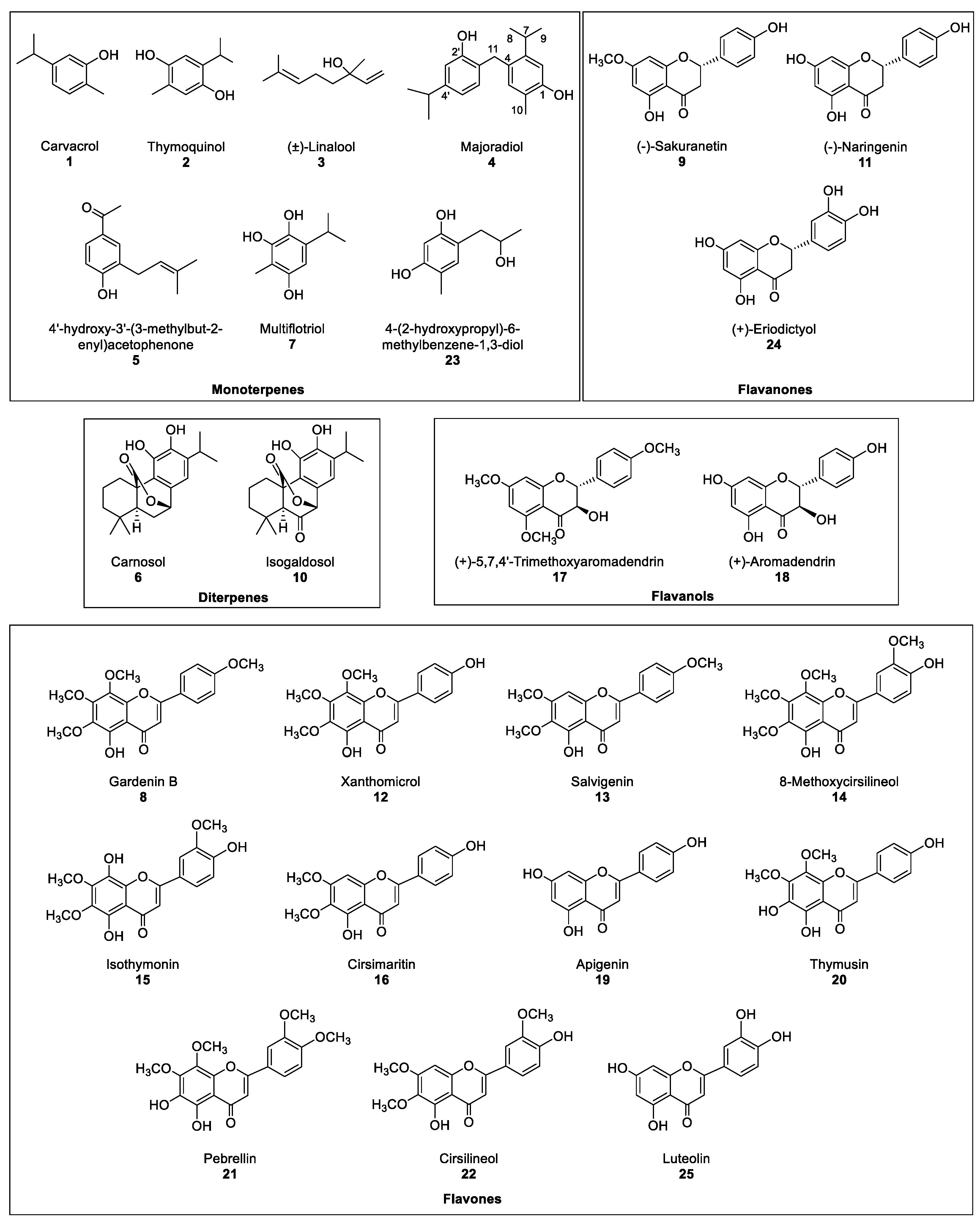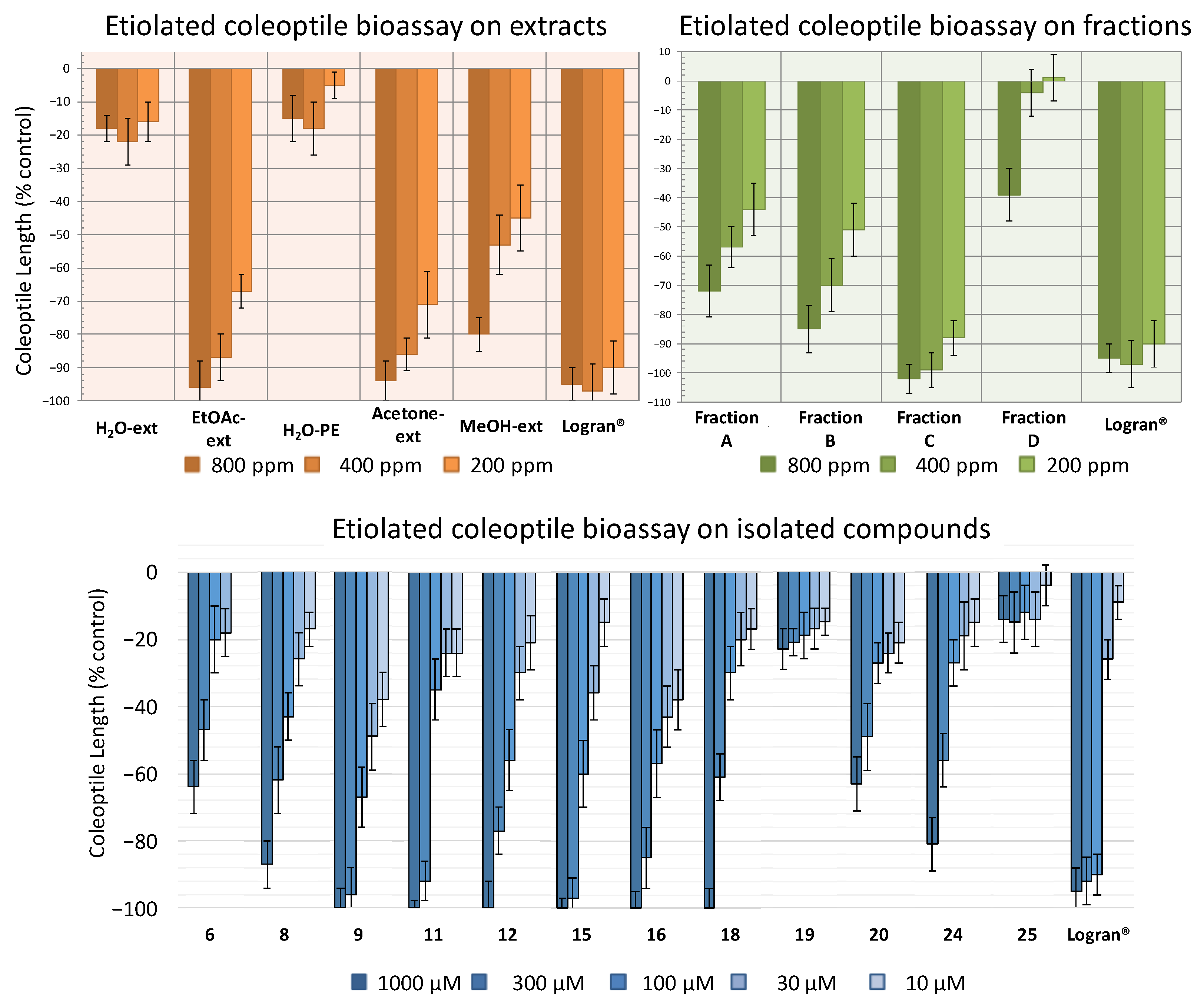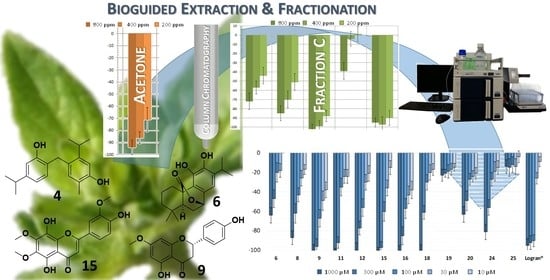A Study on the Phytotoxic Potential of the Seasoning Herb Marjoram (Origanum majorana L.) Leaves
Abstract
1. Introduction
2. Results and Discussion
3. Materials and Methods
3.1. General Experimental Procedures
3.2. Plant Material
3.3. Bioguided Extraction and Purification of Natural Products from O. majorana L. leaves
3.4. Characterization of the Compounds
3.5. Etiolated Wheat Coleoptile Bioassay
3.6. Calculation of IC50 and clogP Values
4. Conclusions
Supplementary Materials
Author Contributions
Funding
Acknowledgments
Conflicts of Interest
References
- Krishnakumar, V.; Potty, S.N. Marjoram. In Handbook of Herbs and Spices; Peter, K.V., Ed.; Elsevier: Philadelphia, PA, USA, 2012; Volume 1, pp. 336–365. [Google Scholar]
- Cinbilgel, I.; Kurt, Y. Oregano and/or marjoram: Traditional oil production and ethnomedical utilization of Origanum species in southern Turkey. J. Herb. Med. 2019, 16, 100257. [Google Scholar] [CrossRef]
- Eddouks, M.; Ajebli, M.; Hebi, M. Ethnopharmacological survey of medicinal plants used in Daraa-Tafilalet region (Province of Errachidia), Morocco. J. Ethnopharmacol. 2017, 198, 516–530. [Google Scholar] [CrossRef] [PubMed]
- Vasudeva, P.; Vasudeva, N. Origanum majorana L. -Phyto-pharmacological review. Indian J. Nat. Prod. Resour. 2015, 6, 261–267. [Google Scholar]
- Busatta, C.; Vidal, R.S.; Popiolski, A.S.; Mossi, A.J.; Dariva, C.; Rodrigues, M.R.A.; Corazza, F.C.; Corazza, M.L.; Vladimir Oliveira, J.; Cansian, R.L. Application of Origanum majorana L. essential oil as an antimicrobial agent in sausage. Food Microbiol. 2008, 25, 207–211. [Google Scholar] [CrossRef] [PubMed]
- Dussault, D.; Vu, K.D.; Lacroix, M. In vitro evaluation of antimicrobial activities of various commercial essential oils, oleoresin and pure compounds against food pathogens and application in ham. Meat Sci. 2014, 96, 514–520. [Google Scholar] [CrossRef]
- Méabed, E.M.H.; El-Sayed, N.M.; Abou-Sreea, A.I.B.; Roby, M.H.H. Chemical analysis of aqueous extracts of Origanum majorana and Foeniculum vulgare and their efficacy on Blastocystis spp. cysts. Phytomedicine 2018, 43, 158–163. [Google Scholar] [CrossRef]
- Vági, E.; Simándi, B.; Suhajda, Á.; Héthelyi, É. Essential oil composition and antimicrobial activity of Origanum majorana L. extracts obtained with ethyl alcohol and supercritical carbon dioxide. Food Res. Int. 2005, 38, 51–57. [Google Scholar] [CrossRef]
- Rezaie, A.; Mousavi, G.; Nazeri, M.; Jafari, B.; Ebadi, A.; Ahmadeh, C.; Habibi, E. Comparative study of sedative, pre-anesthetic and anti-anxiety effect of Origanum majorana extract with diazepam on rats. Res. J. Biol. Sci. 2011, 6, 611–614. [Google Scholar] [CrossRef]
- Erenler, R.; Sen, O.; Aksit, H.; Demirtas, I.; Yaglioglu, A.S.; Elmastas, M.; Telci, I. Isolation and identification of chemical constituents from Origanum majorana and investigation of antiproliferative and antioxidant activities. J. Sci. Food Agric. 2016, 96, 822–836. [Google Scholar] [CrossRef]
- Vera, R.R.; Chane-Ming, J. Chemical composition of the essential oil of marjoram (Origanum majorana L.) from Reunion Island. Food Chem. 1999, 66, 143–145. [Google Scholar] [CrossRef]
- Komaitis, M.E.; Ifanti-Papatragianni, N.; Melissari-Panagiotou, E. Composition of the essential oil of marjoram (Origanum majorana L.). Food Chem. 1992, 45, 117–118. [Google Scholar] [CrossRef]
- Sbayou, H.; Oubrim, N.; Bouchrif, B.; Ababou, B.; Boukachabine, K.; Amghar, S. Chemical Composition and Antibacterial Activity of Essential Oil of Origanum compactum Against Foodborne Bacteria. Int. J. Eng. Res. Technol. 2014, 3, 3562–3567. [Google Scholar]
- Baser, K.H.C.; Kirimer, N.; Tümen, G. Composition of the essential oil of Origanum majorana L. From Turkey. J. Essent. Oil Res. 1993, 5, 577–579. [Google Scholar] [CrossRef]
- Barazandeh, M.M. Essential Oil Composition of Origanum majorana L. from Iran. J. Essent. Oil Res. 2001, 13, 76–77. [Google Scholar] [CrossRef]
- Cala, A.; Molinillo, J.M.G.; Fernández-Aparicio, M.; Ayuso, J.; Álvarez, J.A.; Rubiales, D.; Macías, F.A. Complexation of Sesquiterpene Lactones with Cyclodextrins: Synthesis and Effects on their Activities on Parasitic Weeds. Org. Biomol. Chem. 2017, 15, 6500–6510. [Google Scholar] [CrossRef]
- Rial, C.; García, B.F.; Varela, R.M.; Torres, A.; Molinillo, J.M.G.; Macías, F.A. The Joint Action of Sesquiterpene Lactones from Leaves as an Explanation for the Activity of Cynara cardunculus. J. Agric. Food Chem. 2016, 64, 6416–6424. [Google Scholar] [CrossRef] [PubMed]
- Galindo, J.L.G.; García, B.F.; Torres, A.; Galindo, J.C.G.; Romagni, J.G.; Macías, F.A. The Joint Action in the Bioactivity Studies of Antarctic Lichen Umbilicaria antarctica: Synergic-Biodirected Isolation in a Preliminary Holistic Ecological Study. Phytochem. Lett. 2017, 20, 433–442. [Google Scholar] [CrossRef]
- Lopez-Reyes, J.G.; Spadaro, D.; Prelle, A.; Garibaldi, A.; Gullino, M.L. Efficacy of Plant Essential Oils on Postharvest Control of Rots Caused by Fungi on Different Stone Fruits In Vivo. J. Food Prot. 2013, 76, 631–639. [Google Scholar] [CrossRef]
- Lopez-Reyes, J.G.; Spadaro, D.; Gullino, M.L.; Garibaldi, A. Efficacy of Plant Essential Oils on Postharvest Control of Rot Caused by Fungi on Four Cultivars of Apples In Vivo. Flavour Fragr. J. 2010, 25, 171–177. [Google Scholar] [CrossRef]
- Ibáñez, M.D.; Blázquez, M.A. Herbicidal Value of Essential Oils from Oregano-like Flavour Species. Food Agric. Immunol. 2017, 28, 1168–1180. [Google Scholar] [CrossRef]
- De Almeida, L.F.R.; Frei, F.; Mancini, E.; De Martino, L.; De Feo, V. Phytotoxic Activities of Mediterranean Essential Oils. Molecules 2010, 15, 4309–4323. [Google Scholar] [CrossRef]
- Fuentes-Gandara, F.; Torres, A.; Fernández-Ponce, M.T.; Casas, L.; Mantell, C.; Varela, R.; Martínez de la Ossa-Fernández, E.J.; Macías, F.A. Selective Fractionation and Isolation of Allelopathic Compounds from Helianthus annuus L. Leaves by Means of High-Pressure Techniques. J. Supercrit. Fluids 2019, 143, 32–41. [Google Scholar] [CrossRef]
- Cala, A.; Masi, M.; Cimmino, A.; Molinillo, J.M.G.; Macias, F.A.; Evidente, A. (+)-epi-Epoformin, a Phytotoxic Fungal Cyclohexenepoxide: Structure Activity Relationships. Molecules 2018, 23, 1529. [Google Scholar] [CrossRef] [PubMed]
- Skoula, M.; Grayer, R.J.; Kite, G.C.; Veitch, N.C. Exudate Flavones and Flavanones in Origanum Species and their Interspecific Variation. Biochem. Syst. Ecol. 2008, 36, 646–654. [Google Scholar] [CrossRef]
- Khadhri, A.; Bouali, I.; Aouadhi, C.; Lagel, M.-C.; Masson, E.; Pizzi, A. Determination of Phenolic Compounds by MALDI–TOF and Essential Oil Composition by GC–MS during Three Development Stages of Origanum majorana L. Biomed. Chromatogr. 2019, 33, e4665. [Google Scholar] [CrossRef]
- Vági, E.; Rapavi, E.; Hadolin, M.; Vásárhelyiné Perédi, K.; Balázs, A.; Blázovics, A.; Simándi, B. Phenolic and Triterpenoid Antioxidants from Origanum majorana L. Herb and Extracts Obtained with Different Solvents. J. Agric. Food Chem. 2005, 53, 17–21. [Google Scholar] [CrossRef]
- Hirobe, C.; Qiao, Z.S.; Takeya, K.; Itokawa, H. Cytotoxic Principles from Majorana syriaca. Nat. Med. 1998, 52, 74–77. [Google Scholar]
- Ozaki, Y.; Mochida, K.; Kim, S.-W. Aromatic Annelation with α-Phenylsulfinyl-γ-butyrolactones. A Novel Route to 4-(2-Hydroxyalkyl)-1,3-benzenediols. Chem. Pharm. Bull. 1987, 35, 1790–1795. [Google Scholar] [CrossRef][Green Version]
- González, A.G.; Andrés, L.S.; Aguiar, Z.E.; Luis, J.G. Diterpenes from Salvia mellifera and Their Biogenetic Significance. Phytochemistry 1992, 31, 1297–1305. [Google Scholar] [CrossRef]
- Takahashi, H.; Li, S.; Harigaya, Y.; Onda, M. Heterocycles. XXII.1) Stereoselective Synthesis of (+)-Aromadendrin Trimethyl Ether and Its Enantiomer, and Their Reduction. Chem. Pharm. Bull. 1988, 36, 1877–1881. [Google Scholar] [CrossRef]
- Guo, S.; Cui, X.; Jiang, M.; Bai, L.; Tian, X.; Guo, T.; Liu, Q.; Zhang, L.; Ho, C.-T.; Bai, N. Simultaneous Characterization and Quantification of 17 Main Compounds in Rabdosia rubescens by High Performance Liquid Chromatography. J. Food Drug Anal. 2017, 25, 417–424. [Google Scholar] [CrossRef]
- Abd-Elgawad, A.M.; El Gendy, A.E.-N.G.; Assaeed, A.M.; Al-Rowaily, S.L.; Alharthi, A.S.; Mohamed, T.A.; Nassar, M.I.; Dewir, Y.H.; Elshamy, A.I. Phytotoxic Effects of Plant Essential Oils: A Systematic Review and Structure-Activity Relationship Based on Chemometric Analyses. Plants 2021, 10, 36. [Google Scholar] [CrossRef] [PubMed]
- Lipinski, C.A.; Lombardo, F.; Dominy, B.W.; Feeney, P.J. Experimental and Computational Approaches to Estimate Solubility and Permeability in Drug Discovery and Development Settings. Adv. Drug Deliv. Rev. 2001, 46, 3–26. [Google Scholar] [CrossRef]
- Barbero, G.F.; Molinillo, J.M.G.; Varela, R.M.; Palma, M.; Macías, F.A.; Barroso, C.G. Application of Hansch’s Model to Capsaicinoids and Capsinoids: A Study Using the Quantitative Structure—Activity Relationship. A Novel Method for the Synthesis of Capsinoids. J. Agric. Food Chem. 2010, 58, 3342–3349. [Google Scholar] [CrossRef]
- Zhang, X.; Hung, T.M.; Phuong, P.T.; Ngoc, T.M.; Min, B.-S.; Song, K.-S.; Seong, Y.H.; Bae, K. Anti-inflammatory Activity of Flavonoids from Populus davidiana. Arch. Pharmacal Res. 2006, 29, 1102–1108. [Google Scholar] [CrossRef]
- Yin, J.; Si, C.L.; Wang, M.H. Antioxidant Activity of Flavonoids and Their Glucosides from Sonchus oleraceus L. J. Appl. Biol. Chem. 2008, 51, 57–60. [Google Scholar] [CrossRef]
- González, M.A. Aromatic Abietane Diterpenoids: Their Biological Activity and Synthesis. Nat. Prod. Rep. 2015, 32, 684–704. [Google Scholar] [CrossRef]
- Isobe, T.; Doe, M.; Morimoto, Y.; Nagata, K.; Ohsaki, A. The Anti-Helicobacter pylori Flavones in a Brazilian Plant, Hyptis fasciculata, and the Activity of Methoxyflavones. Biol. Pharm. Bull. 2006, 29, 1039–1041. [Google Scholar] [CrossRef] [PubMed]
- La Cruz, R.A.D.; Cruz-Hipolito, H.E.; Domínguez-Valenzuela, J.A.; Prado, R.D. The Glyphosate Ban in Mexico: Potential Impacts on Agriculture and Weed Management. Pest Manag. Sci. 2021. [Google Scholar] [CrossRef]
- Cordeau, S.; Baudron, A.; Adeux, G. Is Tillage a Suitable Option for Weed Management in Conservation Agriculture? Agronomy 2020, 10, 1746. [Google Scholar] [CrossRef]
- Han, X.; Armstrong, D.W. Using Geminal Dicationic Ionic Liquids as Solvents for High-Temperature Organic Reactions. Org. Lett. 2005, 7, 4205–4208. [Google Scholar] [CrossRef]
- Phutdhawong, W.; Kawaree, R.; Sanjaiya, S.; Sengpracha, W.; Buddhasukh, D. Microwave-Assisted Isolation of Essential oil of Cinnamomum iners Reinw. ex Bl.: Comparison with Conventional Hydrodistillation. Molecules 2007, 12, 868–877. [Google Scholar] [CrossRef] [PubMed]
- Helesbeux, J.-J.; Duval, O.; Guilet, D.; Séraphin, D.; Rondeau, D.; Richomme, P. Regioselectivity in the Ene Reaction of Singlet Oxygen with ortho-Prenylphenol Derivatives. Tetrahedron 2003, 59, 5091–5104. [Google Scholar] [CrossRef]
- Xiao, C.; Dai, H.; Liu, H.; Wang, Y.; Tang, H. Revealing the Metabonomic Variation of Rosemary Extracts Using 1H NMR Spectroscopy and Multivariate Data Analysis. J. Agric. Food Chem. 2008, 56, 10142–10153. [Google Scholar] [CrossRef]
- Ali, M.S.; Saleem, M.; Ali, Z.; Ahmad, V.U. Chemistry of Zataria multiflora (Lamiaceae). Phytochemistry 2000, 55, 933–936. [Google Scholar] [CrossRef]
- Feresin, G.E.; Tapia, A.; Gimenez, A.; Ravelo, A.G.; Zacchino, S.; Sortino, M.; Schmeda-Hirschmann, G. Constituents of the Argentinian Medicinal Plant Baccharis grisebachii and Their Antimicrobial Activity. J. Ethnopharmacol. 2003, 89, 73–80. [Google Scholar] [CrossRef]
- Wollenweber, E.; Dörr, M.; Rivera, D.; Roitman, J.N. Externally Accumulated Flavonoids in Three Mediterranean Ononis Species. Zeitschrift für Naturforschung C 2003, 58, 771–775. [Google Scholar] [CrossRef]
- Jassbi, A.R.; Zamanizadehnajari, S.; Azar, P.A.; Tahar, S. Antibacterial Diterpenoids from Astragalus brachystachys. Zeitschrift für Naturforschung C 2002, 57, 1016–1021. [Google Scholar] [CrossRef]
- Bai, N.; He, K.; Zhou, Z.; Lai, C.-S.; Zhang, L.; Quan, Z.; Shao, X.; Pan, M.-H.; Ho, C.-T. Flavonoids from Rabdosia rubescens Exert Anti-inflammatory and Growth Inhibitory Effect against Human Leukemia HL-60 Cells. Food Chem. 2010, 122, 831–835. [Google Scholar] [CrossRef]
- Van Loo, P.; De Bruyn, A.; Buděšínský, M. Reinvestigation of the Structural Assignment of Signals in the 1H and 13C NMR Spectra of the Flavone Apigenin. Magn. Reson. Chem. 1986, 24, 879–882. [Google Scholar] [CrossRef]
- Horie, T.; Kawamura, Y.; Yamamoto, H.; Kitou, T.; Yamashita, K. Synthesis of 5,8-Dihydroxy-6,7-dimethoxyflavones and Revised Structures for Some Natural Flavones. Phytochemistry 1995, 39, 1201–1210. [Google Scholar] [CrossRef]
- Gohari, A.R.; Saeidnia, S.; Gohari, M.R.; Moradi-Afrapoli, F.; Malmir, M.; Hadjiakhoondi, A. Bioactive Flavonoids from Satureja atropatana Bonge. Nat. Prod. Res. 2009, 23, 1609–1614. [Google Scholar] [CrossRef]
- Park, Y.; Moon, B.-H.; Lee, E.; Lee, Y.; Yoon, Y.; Ahn, J.-H.; Lim, Y. 1H and13C-NMR Data of Hydroxyflavone Derivatives. Magn. Reson. Chem. 2007, 45, 674–679. [Google Scholar] [CrossRef] [PubMed]
- Cárdenas, D.M.; Cala, A.; Molinillo, J.M.; Macías, F.A. Preparation and Phytotoxicity Study of Lappalone from Dehydrocostuslactone. Phytochem. Lett. 2017, 20, 66–72. [Google Scholar] [CrossRef]
- PRISM 5.00; GraphPad Software, Inc.: San Diego, CA, USA, 2007.
- Cala, A.; Zorrilla, J.G.; Rial, C.; Molinillo, J.M.G.; Varela, R.M.; Macías, F.A. Easy Access to Alkoxy, Amino, Carbamoyl, Hydroxy, and Thiol Derivatives of Sesquiterpene Lactones and Evaluation of Their Bioactivity on Parasitic Weeds. J. Agric. Food Chem. 2019, 67, 10764–10773. [Google Scholar] [CrossRef] [PubMed]





| Compound | IC50 (μM) | R2 | clogP | Compound | IC50 (μM) | R2 | clogP |
|---|---|---|---|---|---|---|---|
| 6 | 412 | 0.979 | 3.163 | 18 | 215.4 | 0.968 | 1.368 |
| 8 | 159 | 0.986 | 3.033 | 19 a | - | - | 2.905 |
| 9 | 32.3 | 0.969 | 2.967 | 20 | 496 | 0.953 | 2.273 |
| 11 | 123 | 0.937 | 2.445 | 24 | 275 | 0.988 | 1.848 |
| 12 | 84.5 | 0.988 | 2.448 | 25 a | - | - | 2.311 |
| 15 | 58.3 | 0.986 | 1.871 | Logran® | 42.9 | 0.979 | - |
| 16 | 56.6 | 0.946 | 2.860 |
Publisher’s Note: MDPI stays neutral with regard to jurisdictional claims in published maps and institutional affiliations. |
© 2021 by the authors. Licensee MDPI, Basel, Switzerland. This article is an open access article distributed under the terms and conditions of the Creative Commons Attribution (CC BY) license (https://creativecommons.org/licenses/by/4.0/).
Share and Cite
Cala, A.; Salcedo, J.R.; Torres, A.; Varela, R.M.; Molinillo, J.M.G.; Macías, F.A. A Study on the Phytotoxic Potential of the Seasoning Herb Marjoram (Origanum majorana L.) Leaves. Molecules 2021, 26, 3356. https://doi.org/10.3390/molecules26113356
Cala A, Salcedo JR, Torres A, Varela RM, Molinillo JMG, Macías FA. A Study on the Phytotoxic Potential of the Seasoning Herb Marjoram (Origanum majorana L.) Leaves. Molecules. 2021; 26(11):3356. https://doi.org/10.3390/molecules26113356
Chicago/Turabian StyleCala, Antonio, José R. Salcedo, Ascensión Torres, Rosa M. Varela, José M. G. Molinillo, and Francisco A. Macías. 2021. "A Study on the Phytotoxic Potential of the Seasoning Herb Marjoram (Origanum majorana L.) Leaves" Molecules 26, no. 11: 3356. https://doi.org/10.3390/molecules26113356
APA StyleCala, A., Salcedo, J. R., Torres, A., Varela, R. M., Molinillo, J. M. G., & Macías, F. A. (2021). A Study on the Phytotoxic Potential of the Seasoning Herb Marjoram (Origanum majorana L.) Leaves. Molecules, 26(11), 3356. https://doi.org/10.3390/molecules26113356








